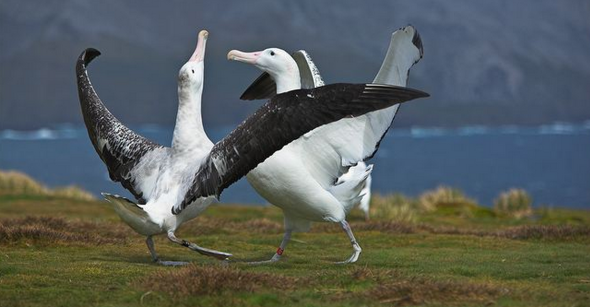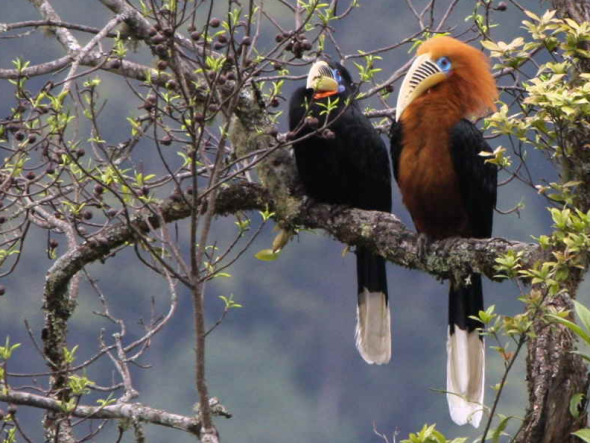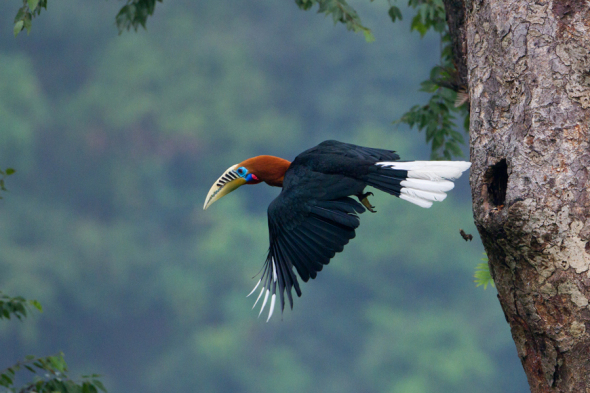Endangered Species Friday: Diomedea amsterdamensis - An Ocean of Grief.
Endangered Species Friday: Diomedea amsterdamensis
This Friday’s (ESP) Endangered Species watch Post I dedicate to one of the most stunning and adorable of all plane like birds. Listed as [critically endangered] and identified back in 1983 by South African Dr Jean Paul Roux whom is a Marine Biologist studying Zoology, Systems Biology and Marine Biology at the University of Cape Town, South Africa Jean Paul Roux works full-time at the Department of Biological Sciences, Cape Town. (Image D. amsterdamensis fledglings)
(Image: Birdingblogs.com)
Commonly identified as the Amsterdam Albatross or Amsterdam Island Albatross the species was listed as [critically endangered] back in 2012. This gorgeous bird is endemic to the French Southern Territories of which its populations are continuing to decline at a rapid pace. Populations were estimated at a mere 170 individuals which in turn ranks as the worlds most endangered species of bird. Out of the 170 individuals there are a total of 80 mature individuals consisting of 26 pairs that breed annually.
Between 2001-2007 there were a total of 24-31 breeding pairs annually, which leaves a slightly lower population count today of around 100 mature individuals. Back in 1998 scientists stated that there were no fewer than 50 mature individuals if that. The Amsterdam Albatross doesn’t naturally have a small population however qualified for the category of [critically endangered] due to this reason when identified in 1983. Furthermore pollution, habitat destruction and disease remain pivotal factors that’s decreasing populations furthermore. The video below from MidWay island explains a little more about pollution and birds of this caliber.
Its quite possible that there could be more unidentified groups within the local territory or elsewhere, unfortunately as yet there is no evidence to suggest the Amsterdam Albatross is located anywhere else, however there have been sightings, which do not necessarily count as the species being endemic to countries the bird may have been noted within.
The species breeds on the Plateau des Tourbières on Amsterdam Island (French Southern Territories) in the southern Indian Ocean. An increase of populations was documented via census back in 1984, a year after identification. Marine Biologists have stated that population sizes may have been more larger when its range was more extensive over the slopes of the island.
Meanwhile in South Africa satellite tracking data has indicated the Amsterdam Albatross ranges off the coast of Eastern South Africa to the South of Western Australia in non-breeding pairs. There have been some [possible] sightings over Australia through to New Zealand too. Meanwhile South Africa “may” have its first breeding pair this must not be taken as factual though. Back in 2013 a nature photographer photographed an Amsterdam Albatross off the Western Cape of South Africa which is the very first documented and confirmed sighting [2013].
AN OCEAN OF GRIEF
Breeding is biennial (when successful) and is restricted to the central plateau of the island at 500-600 m, where only one breeding group is known. Pair-bonds are lifelong, and breeding begins in February. Most eggs are laid from late February to March, and chicks fledge in January to February the following year.
Immature birds begin to return to breeding colonies between four and seven years after fledging but do not begin to breed until they are nine years of age. The Amsterdam Albatross exact diet is unknown, but probably consists of fish, squid and crustaceans. During the breeding season, birds forage both around Amsterdam Island and up to 2,200 km away in subtropical waters which is something of interest. During the great Sardine Run many aquatic species consisting of birds, seals, sharks and whales hit the South African oceans hard for sardines. So I am calling on my fellow South African friends to please be on the lookout for this rather elusive bird.
Read more here on the Avian Biology.
Image: Amsterdam Albatross mating ritual, credited to Andrew Rouse.
Diomedea amsterdamensis, is quite a large albatross. When described in 1983, the species was thought by some researchers to be a sub-species of the wandering albatross, D. exulans. Bird Life International and the IOC recognize it as a species, James Clements does not, and the SACC has a proposal on the table to split the species. Please refer to the link above on Avian Biology which will explain more on the bird and its current classification.
More recently, mitchondrial DNA comparisons between the Amsterdam albatross, the wandering albatross Diomedea exulans, the Antipodean albatross D. antipodensis and the Tristan albatross D. dabbenena, provide clear genetic evidence that the Amsterdam albatross is a separate species.
Threats
Degradation of breeding sites by introduced cattle has decreased the species’s range and population across the island. Human disturbance is presumably also to blame. Introduced predators are a major threat, particularly feral cats. Interactions with longline fisheries around the island in the 1970s and early 1980s could also have contributed to a decline in the population.
Today the population is threatened primarily by the potential spread of diseases (avian cholera and Erysipelothrix rhusiopathiae) that affect the Indian Yellow-nosed Albatross Thalassarche carteri population 3 km from the colony. Infection risks are very high and increased chick mortality over recent years suggests the population is already affected.
The foraging range of the species overlaps with longline fishing operations targeting tropical tuna species, so bycatch may also still be a threat, and a recent analysis has suggested that bycatch levels exceeding six individuals per year would be enough to cause a potentially irreversible population decline. Having a distribution on relatively low-lying islands, this species is potentially susceptible to climate change through sea-level rise and shifts in suitable climatic conditions. Plastic pollution has also been noted as problematic.
International Animal Rescue Foundation Africa and International Animal Rescue Foundation France are currently working on projects to reduce more plastic within bird habitat that has never been visited by the organisation before. The current plight of bird habitat and plastic pollution within the Pacific ocean needs to be worked on by everyone, furthermore addressed immediately.
To date all twenty two species within the four genera of Albatross are heavily threatened with extinction. There remains no species at present that is listed as [least concern]. The future is indeed very bleak for all 22 species and something we now need to work on and towards to preserve Albatross’s before extinction occurs within a decade for the vast majority of all twenty two species and sub-species.
Thank you for reading.
Please share to make aware the plight of this stunning bird and the remaining twenty two species too.
Dr Jose C. Depre.
Botanical and Environmental Scientist.
A planet without birds is a world not worth living within anymore. Daily I am traumatized and deeply disturbed at viewing the destruction we have caused to these stunning animals and, their natural habitat. I am pained, deeply frustrated and infuriated at international retail companies whom preach good yet practice negligence killing off via plastic pollution our species of birds. Jose Depre
Endangered Species Friday: Aceros nipalensis
Endangered Species Friday: Aceros nipalensis
This Fridays (ESP) - Endangered Species watch Post I have chosen to document on this stunning species known commonly as the Rufous-cheeked Hornbill, because of large population declines throughout most of the birds historical range. More awareness needs to be created with regards to this particular bird specie due to their natural habitat declining and localized extinctions that have already occurred in the past decade. Furthermore extinctions are now likely to occur within Viet Nam and [west] Thiland where hunting is the primary threat to the species.. (Image credit Ian Fulton).
Identified back in 1829 by Mr Brian Houghton Hodgson (1 February 1800 or more likely 1801– 23 May 1894) was a pioneer naturalist and ethnologist working in India and Nepal where he was a British Resident. He described numerous species of birds and mammals from the Himalayas, and several birds were named after him by others such as Edward Blyth.
Listed as vulnerable the A. nipalensis is endemic to Bhutan; China; India; Lao People’s Democratic Republic; Myanmar; Thailand and Viet Nam. Unfortunately A. nipalensis has already been declared extinct locally in Nepal. Like many large birds within this region of Asia the Rufous-cheeked (or necked) Hornbill’s populations are declining quite extensively throughout their range of which deforestation and habitat degradation and, hunting is primarily to blame.
The species has been listed on Cites Appendix (I-II) of which an estimated population census count has determined there are no less than 2,500 birds but no greater than 9,999. A survey count back in 2001 by Bird-Life International concluded that from the [estimate] above the [true] population count is actually by far more lower than previously suggested, however few conservationists are now debating this due to the birds ‘alleged’ extensive range within South East Asia.
From the Bird Life International (2001) census the organisation stated there was no fewer than 1,667 mature individuals but no greater than 6,666, which is rounded to 1,500 to 7,000 mature individuals exactly. Since the last 2001 census its quite possible populations have increased and decreased to date.
A. nipalensis is known to inhabit the following ranges; Bhutan, north-east India, Myanmar, southern Yunnan and south-east Tibet, China, [west] Thailand, Laos and Viet Nam. The species has declined [drastically] and is no longer common throughout most of its known historical range. While we know the species is now regionally extinct within Nepal the next likely localized extinction may very well be within Viet Nam of which its populations have fallen to alarming rates.
Within [most] of Thailand where the species was quite common reports have sadly indicated the bird is no longer commonly seen, and like Viet Nam, Thailand could become the third county to see localized extinctions occurring too, the only known habitat within Thailand that A nipalensis occurs now is within west Thailand. To date reports have confirmed that within Bhutan A. nipalensis remains pretty much common of which Bhutan is known to the birds [largest] stronghold.
Healthy large populations have also been documented back in 2007 within Namdapha National Park, India, Nakai-Nam Theun National Biodiversity Conservation Area, central Laos and perhaps also Huai Kha Khaeng, [west Thailand], and Xishuangbanna Nature Reserve, China. Some conservationists have been led to believe that while populations are considered quite large within these strongholds that the species may very well be “more widespread than previously thought”. Meanwhile the species is known to inhabit north Myanmar, and there are recent records from West Bengal and Eaglenest Wildlife Sanctuary, Arunachal Pradesh, India.
Rufous-cheeked Hornbill commonly resides within broad-leaved forest, some reports have also indicated the species to be present within dry woodland too. Mating and nesting normally occurs from the months of March to June within large wide girth trees, the very trees that the species depends on though are being felled throughout most of the Hornbills historical range.
Image: Rufous-necked-Hornbill (Photographer unknown)
Major Threats
Its dependence on large trees for feeding and nesting makes it especially susceptible to deforestation and habitat degradation through logging, shifting cultivation and clearance for agriculture. Furthermore, viable populations require vast tracts of forest to survive, exacerbating its susceptibility to habitat fragmentation. These problems are compounded by widespread hunting and trapping for food, and trade in pets and casques. Hunting is the primary threat to the species in Arunachal, India. A report from the Wildlife Extra organisation details poaching incidents with regards to Hornbills.
Wildlife Extra stated:
The unique and intriguing breeding habits that caught Pilai Poonswad attention are central to the birds’ plight. Each hornbill pair seeks out a suitable hollow – 15 to 40 metres above the ground in the trunk or branch of a Neobalanocarpus, Dipterocarpus or Syzygium tree – in which to raise a single chick. When a suitable cavity is found, the female walls herself in, using mud supplied by her mate and regurgitated food, to hatch and rear her chick. The male feeds them for the next three months and, if he fails, both mother and chick may perish. The birds consume up to 80 different kinds of fruit, scattering the seeds over many hectares of forest. With other seed-distributing animals such as monkeys now scarce, the hornbill has become pivotal in maintaining the integrity of the forest. But the birds rarely spread the seeds of the trees in which they nest: if these disappear, the hornbills too will vanish – and the trees and plants they help propagate will soon follow.
Click the link above via the [report] to read more on this very fascinating conservationist.
My name is Dr Jose Carlos Depre, MD, B.Env.Sc, BSBio, D.V.M. I myself have been working within bird, tree kangaroo and pachydermata conservation, rescue and reporting for over fifteen years.
Within these unique, wonderful and exhilarating years I have witnessed one of my favorite species of animals [birds] declining to worrying levels that is now so concerning it has led to sleepless nights for many years. Should we continue to see such catastrophic population decreases of birds we’ll eventually witness alarming declines of plants and trees. The same applies with insects and herbivorous mammals too.
Like insects birds are incredibly important for both human and animal survival. The vast majority of all bird species rely on plants for their staple diet. On consuming fruits, leaves, flowers Etc, the very seeds within the birds diet of life needed to continue seed dispersal will be lost should all bird populations go extinct. Should this occur we selfish humans will then become the Planets seed disperses. Think about that next time you fell a tree or rip a plant up.
Dr Jose. C. Depre
Environmental and Botanical Scientist.
Thank you for reading and please share fare and wide to create as much awareness for all Hornbills as possible.






